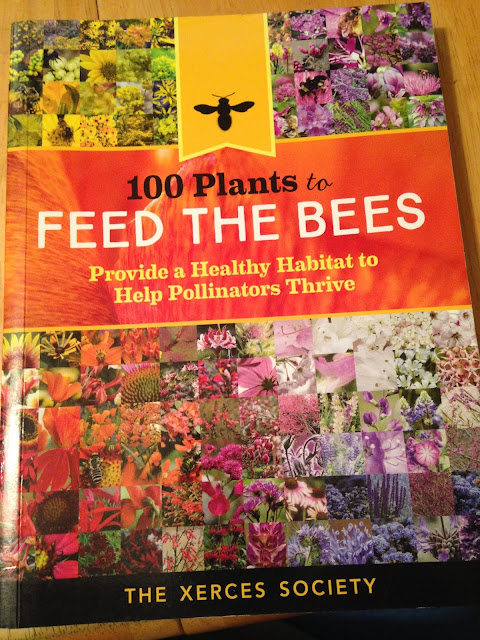An Amazing Book if you Want Pollinators - and who doesn't?
I bought the best gardening book a few springs ago. It's 100 Plants to Feed the Bees. It's a publication of The Xerces Society (https://xerces.org), an international non-profit that
works for the conservation of invertebrates and their habitats. It's
named for the Xerces Blue butterfly, "...the first butterfly known to go extinct in North America as a result of human activities." How sad. Even more so when I found out that this little beauty lived in the coastal sand dunes of San Francisco, where if I had been around a decade or two earlier, I could have seen. Urban development ended its life, permanently. Ironically, the land is now part of the Golden Gate National Recreation Area, an over 80,000 acre "ecologically significant" landscape.
This book was tremendously important to me in my quest for great pollinator plants for my Butterfly Garden, and my under-construction Pollinator Garden.
The book gives detailed information on 100 (thus the title!) bee magnet plants. The chapters include Native Wildflowers, Native Trees and Shrubs, Introduced Trees and Shrubs, Introduced Herbs and Ornamentals, and Native and Nonnative Bee Pasture Plants.
It's not all about bees though, the information is great for those wanting to draw more hummingbirds and butterflies to their gardens too.
Each plant profile shows through silhouette icons what pollinators visit that plant, a map of where it grows native, its uses, the quality of the nectar (% sugar), along with the recommended species or varieties for different US areas. Each plant is given a two page spread (I think plum, cherry, almond, peach trees may be the only one with more) And the photography is amazing!
Here's the information on beebalm. Every single one of the 100 plants featured is given this same fabulous treatment!

How many of the plants included do I have? More than I thought! A few are still in their seed form, the native wildflower annuals (poppies, godetia, sunflowers, black-eyed Susan, etc.) and new native perennials (new types of penstemon, asters, pink lupine). Many are established perennial native wildflowers (beebalm, Russell lupine, salvias for instance), shrubs (blueberries). Then there are the three introduced fruit trees (cherry, pluot, and peach). I own most of the introduced herbs listed! I love my herbs! The only ones I do not have are basil and coriander (if you let cilantro go to seed you have coriander seeds!), annuals I do grow, and already have seeds to do so, and Russian sage, not a culinary sage, more of a shrub, which is actually on my "want" list.
I won't be needing pasture plants, and have no proper planting areas for the shrubs and trees (my blueberries are in containers). Some of the native wildflowers are ugly and not really the sort of things for an ornamental bed!
So, I have 30 from the list. 30/100 is pretty good, if it's not an exam grade! Plus, really I have more than that 30, since I have more than one of some, and more than one variety of others. I'm thinking... maybe closer to 50!
This book was tremendously important to me in my quest for great pollinator plants for my Butterfly Garden, and my under-construction Pollinator Garden.
The book gives detailed information on 100 (thus the title!) bee magnet plants. The chapters include Native Wildflowers, Native Trees and Shrubs, Introduced Trees and Shrubs, Introduced Herbs and Ornamentals, and Native and Nonnative Bee Pasture Plants.
It's not all about bees though, the information is great for those wanting to draw more hummingbirds and butterflies to their gardens too.
Each plant profile shows through silhouette icons what pollinators visit that plant, a map of where it grows native, its uses, the quality of the nectar (% sugar), along with the recommended species or varieties for different US areas. Each plant is given a two page spread (I think plum, cherry, almond, peach trees may be the only one with more) And the photography is amazing!
Here's the information on beebalm. Every single one of the 100 plants featured is given this same fabulous treatment!

How many of the plants included do I have? More than I thought! A few are still in their seed form, the native wildflower annuals (poppies, godetia, sunflowers, black-eyed Susan, etc.) and new native perennials (new types of penstemon, asters, pink lupine). Many are established perennial native wildflowers (beebalm, Russell lupine, salvias for instance), shrubs (blueberries). Then there are the three introduced fruit trees (cherry, pluot, and peach). I own most of the introduced herbs listed! I love my herbs! The only ones I do not have are basil and coriander (if you let cilantro go to seed you have coriander seeds!), annuals I do grow, and already have seeds to do so, and Russian sage, not a culinary sage, more of a shrub, which is actually on my "want" list.
I won't be needing pasture plants, and have no proper planting areas for the shrubs and trees (my blueberries are in containers). Some of the native wildflowers are ugly and not really the sort of things for an ornamental bed!
So, I have 30 from the list. 30/100 is pretty good, if it's not an exam grade! Plus, really I have more than that 30, since I have more than one of some, and more than one variety of others. I'm thinking... maybe closer to 50!



Beautiful book! Thank you for sharing. I wonder if our library has a copy as I'm on a tight budget. Lucky for me, a local garden center gives free seminars, and one was on this very topic. It was interesting. Bee well! ~grin~
ReplyDelete